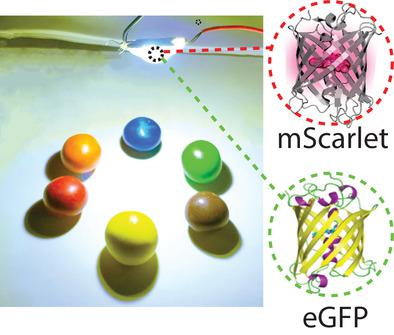当前位置:
X-MOL 学术
›
Adv. Mater. Technol.
›
论文详情
Our official English website, www.x-mol.net, welcomes your
feedback! (Note: you will need to create a separate account there.)
Ultra‐Efficient and High‐Quality White Light‐Emitting Devices using Fluorescent Proteins in Aqueous Medium
Advanced Materials Technologies ( IF 6.4 ) Pub Date : 2020-05-04 , DOI: 10.1002/admt.202000061
Sadra Sadeghi 1 , Rustamzhon Melikov 2 , Deniz Conkar 3 , Elif Nur Firat‐Karalar 3 , Sedat Nizamoglu 1, 2
Advanced Materials Technologies ( IF 6.4 ) Pub Date : 2020-05-04 , DOI: 10.1002/admt.202000061
Sadra Sadeghi 1 , Rustamzhon Melikov 2 , Deniz Conkar 3 , Elif Nur Firat‐Karalar 3 , Sedat Nizamoglu 1, 2
Affiliation

|
The transformation of electronics toward “green” and efficient devices is critical for the environmental sustainability and energy future. So far, majority of efficient lighting devices have been realized by artificial optical materials such as rare‐earth‐elements‐doped phosphors, colloidal quantum dots (QDs) and dyes. In this study, red‐emitting mScarlet and green‐emitting eGFP fluorescent proteins are determined for high‐performance white LEDs, expressed in living Escherichia coli and the purified proteins are integrated in their natural aqueous environment onto blue LED chips. The aqueous integration preserved quantum yield levels of the proteins above 70% in the device architecture and facilitated a high luminous efficiency (LE) of 81 lm W−1 with a color rendering index (CRI) of 83, which is the most efficient eco‐friendly white LED reported to date. Moreover, the concentration ratio are also optimized of red‐ and green‐emitting proteins and white protein‐based LEDs with a maximum CRI of 92 are demonstrated. This study shows that fluorescent proteins hold great promise for the next generation eco‐friendly, efficient and high‐quality white light sources.
中文翻译:

在水性介质中使用荧光蛋白的超高效和高质量白光发射装置
电子设备向“绿色”高效设备的转变对于环境的可持续发展和能源的未来至关重要。到目前为止,大多数有效的照明设备都是通过人工光学材料实现的,例如稀土元素掺杂的荧光粉,胶体量子点(QD)和染料。在这项研究中,测定了在活的大肠杆菌中表达的高性能白光LED的发红光的mScarlet和发绿光的eGFP荧光蛋白,并将纯化的蛋白在其天然水性环境中整合到蓝光LED芯片上。水的整合使器件结构中蛋白质的量子产率保持在70%以上,并促进了81 lm W -1的高发光效率(LE)显色指数(CRI)为83,这是迄今为止报道的最高效的环保白光LED。此外,还优化了红色和绿色发光蛋白的浓度比,并展示了最大CRI为92的基于白色蛋白的LED。这项研究表明,荧光蛋白对于下一代环保,高效和高质量的白光源具有广阔的前景。
更新日期:2020-05-04
中文翻译:

在水性介质中使用荧光蛋白的超高效和高质量白光发射装置
电子设备向“绿色”高效设备的转变对于环境的可持续发展和能源的未来至关重要。到目前为止,大多数有效的照明设备都是通过人工光学材料实现的,例如稀土元素掺杂的荧光粉,胶体量子点(QD)和染料。在这项研究中,测定了在活的大肠杆菌中表达的高性能白光LED的发红光的mScarlet和发绿光的eGFP荧光蛋白,并将纯化的蛋白在其天然水性环境中整合到蓝光LED芯片上。水的整合使器件结构中蛋白质的量子产率保持在70%以上,并促进了81 lm W -1的高发光效率(LE)显色指数(CRI)为83,这是迄今为止报道的最高效的环保白光LED。此外,还优化了红色和绿色发光蛋白的浓度比,并展示了最大CRI为92的基于白色蛋白的LED。这项研究表明,荧光蛋白对于下一代环保,高效和高质量的白光源具有广阔的前景。



































 京公网安备 11010802027423号
京公网安备 11010802027423号